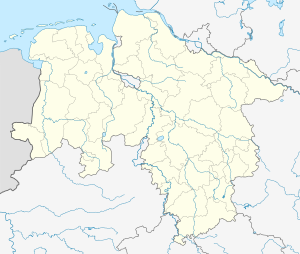Endelskamp tunnel
| Endelskamp tunnel | ||
|---|---|---|
|
View of the south portal (2010)
|
||
| traffic connection | High-speed line from Hanover to Würzburg | |
| length | 673 m | |
| Number of tubes | 1 | |
| Largest coverage | 20 m | |
| construction | ||
| Client | German Federal Railroad | |
| start of building | January 1984 (start of tunneling) | |
| completion | September 1984 (end of tunneling) | |
| business | ||
| operator | DB network | |
| release | 1991 | |
| location | ||
|
|
||
| Coordinates | ||
| North portal | 51 ° 27 ′ 48 ″ N , 9 ° 49 ′ 6 ″ E | |
| South portal | 51 ° 27 ′ 31 ″ N , 9 ° 48 ′ 44 ″ E | |
The Endelskamp tunnel is a 673 m long railway tunnel on the high-speed line Hanover – Würzburg ( route kilometers 110.8 to 111.4). It crosses under the up to 315 m high Endelskamp with the southern Lower Saxon community of Dransfeld and therefore bears his name.
The inner shell is 30 cm thick.
course
The route runs straight in the tunnel. The gradient rises continuously towards the south portal, but increasingly flattens out in its course. Layers of the middle and lower shell limestone are passed through . The cover is up to 20 m.
A short incision is located in front of the tunnel to the north, which is followed by the Leinebuschtunnel . The Jühnde overtaking station follows to the south .
history
planning
Originally, a cut was planned in this area. From a technical, economic and landscape protection point of view, the decision was made in favor of the tunnel section. The 673 m length that was realized was already planned at the end of 1983.
construction
Preparatory work for the tunnel construction began at the end of 1983. Tunneling began in January 1984 and was completed in September 1984. Because of the low cover, the tube was built using an open cut . Which sponsorship Annegredt Engelhardt took over.
In addition to the Leinebusch and Mackenrodt tunnels, the tunnel is part of a series of three tubes. A total of 390,000 m³ was excavated for the three structures and 675,000 m³ were excavated for the pre-cuts. A total of 81,000 m³ of concrete and 4,400 t of steel were used; the construction period ran from 1984 to 1986. The total cost of all three tubes was 95 million Deutschmarks. The companies Dyckerhoff & Widmann AG (Frankfurt am Main) and E. Heitkamp GmbH ( Herne ) were commissioned.
In the entire section between the south portal of the Leinebuschtunnel (km 110.0) and the north portal of the Rau hebel tunnel, around 1.3 million m³ of excess material accumulated.
Web links
Individual evidence
- ↑ a b c d e Deutsche Bundesbahn, Bundesbahndirektion Hannover, project group Hannover – Würzburg North of the railway construction center: Tunnel construction in the northern section of the new Hanover – Würzburg line , brochure (22 pages), status: January 1987, p. 16
- ↑ a b DB project group Hanover-Würzburg (North) (Ed.): New Hanover-Würzburg line: Jühnde , brochure (14 pages, folded) as of October 1, 1984
- ↑ a b DB project group Hanover-Würzburg (North) (ed.): New Hanover-Würzburg line: Rosdorf, Mengershausen , brochure (12 pages, folded) as of September 1, 1983
- ^ A b c Deutsche Bundesbahn, Federal Railway Directorate Hanover, Project Group Hanover – Würzburg North of the Bahnbauzentrale (publisher): New Hanover – Würzburg line. The Göttingen – Kassel section , 36 A4 pages, Hanover, October 1983, p. 23 f.
- ↑ Belter: Great progress in building the tunnels for the new lines . In: Der Eisenbahningenieur , 34, 1983, issue 12, p. 661 f.
- ^ Project group NBS Hanover of the Bahnbauzentrale, Bundesbahndirektion Hanover (ed.): Tunnel construction in the northern section of the new Hanover - Würzburg line . Brochure as of November 1987, p. 18.

